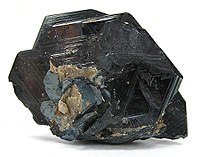
Photo from wikipedia
We demonstrate a facile selective synthesis of phase-pure anatase, rutile, and brookite nanocrystal polymorphs of titania (TiO2) using a benign hydrothermal treatment of an industrial grade TiOSO4 precursor. Acetic acid… Click to show full abstract
We demonstrate a facile selective synthesis of phase-pure anatase, rutile, and brookite nanocrystal polymorphs of titania (TiO2) using a benign hydrothermal treatment of an industrial grade TiOSO4 precursor. Acetic acid (CH3COOH) is used for the synthesis of anatase, glycolic acid (HOCH2COOH) is used for rutile, and both glycolic acid and ammonium hydroxide (NH4OH) are used for obtaining brookite. The detailed morphologies of the as-synthesized materials are determined from a combination of powder X-ray diffraction, transmission electron microscopy, and Raman spectroscopy. The anatase nanocrystals are terminated by low-energy {101} facets and a small amount of high-energy {001} facets, whereas the rutile nanocrystals are terminated by low-energy {110} facets and a small amount of high-energy {111} facets. The brookite nanocrystals are terminated by low-energy {210} facets and {111} facets, and not the high-energy {101} and {201} facets erroneously reported in the literature. The activities of as-synthesized TiO2 nanocrystals as supports for vanadia-titania catalysts are investigated by measuring the selective catalytic reduction of NO using ammonia (NH3-SCR). The O2-activated samples show similar oxidovanadium(V) bands in their Raman spectra, and the relative activity relation is found to be anatase > brookite > rutile. In addition, the photocatalytic activity is evaluated by measuring the decomposition of Rhodamine B (RhB) under UV-light irradiation, and the relative activity order is found to be P25 > anatase ≈ rutile > brookite.
Journal Title: Inorganic chemistry
Year Published: 2020
Link to full text (if available)
Share on Social Media: Sign Up to like & get
recommendations!